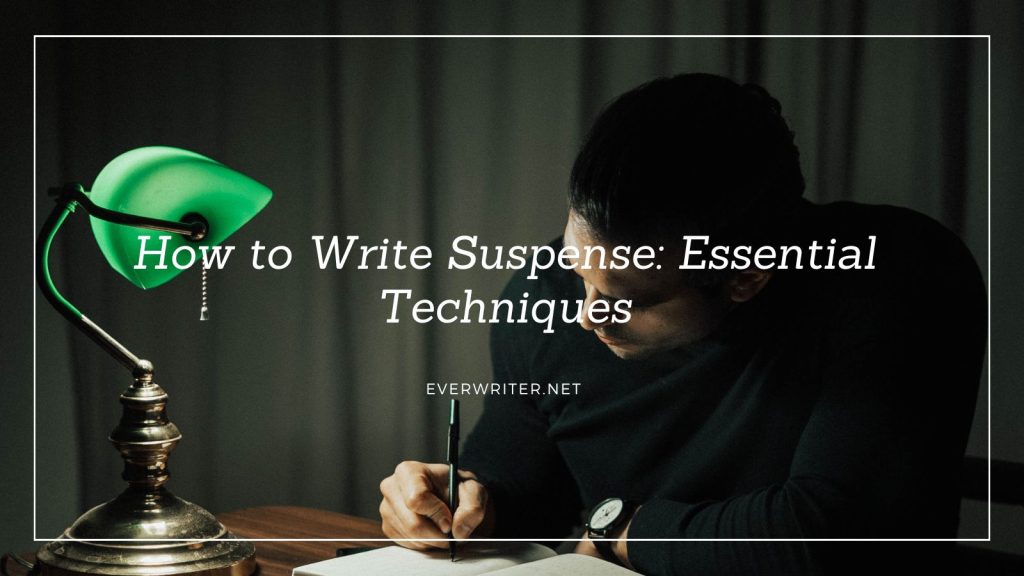Creating Suspense: Techniques to Keep the Reader Awaits and Surprised

The Essence of Suspense in Storytelling
Suspense is an essential component that transforms ordinary storytelling into an engaging and unforgettable experience. By manipulating tension and pacing, writers can create a psychological grasp that compels readers to engage with the plot fully. Suspense keeps readers at the edge of their seats, not merely through thrill but by enticing them with the unexpected. By effectively employing various techniques, writers can craft narratives that resonate deeply with their audiences.
Among the most impactful strategies for generating suspense is the use of unpredictable plot twists. This technique can turn a straightforward narrative into a labyrinth of surprises. Take, for example, a seemingly innocent character who is later revealed to have a shocking, dark backstory. By incorporating twists that challenge readers’ expectations, writers can keep them guessing, ultimately leading to a more rewarding reading experience.
Cliffhangers also serve as a critical tool for maintaining suspense. By concluding chapters or pivotal sections with unresolved questions or precarious situations, writers create an immediate need for resolution. An example can be seen in popular Nigerian thrillers, where a protagonist might find themselves at a crossroads, leaving readers eager to unravel what happens next. The anticipation built up by these cliffhangers can dramatically affect the rhythm of the storytelling, making every turn of the page a moment of tension and excitement.
Foreshadowing is another compelling technique. This subtle art consists of dropping hints or clues throughout the narrative, guiding readers’ expectations while letting them remain unaware of the impending payoff. A masterful example can often be found in traditional folktales, where early depictions of a character’s traits foreshadow future actions, demonstrating how deeply embedded cultural narratives can inspire suspenseful storytelling.
Using a limited perspective can inject an enticing air of mystery. When the narrator is unreliable or the viewpoint is restricted, the audience is left to piece together the puzzle. This technique can create a rich environment for discussions about trust, perspective, and perception in storytelling, making the narrative complex and thought-provoking.

Incorporating elements of local culture into suspenseful narratives amplifies the impact on Nigerian readers. The vibrant storytelling customs found in diverse Nigerian folklore—rich with moral lessons, supernatural events, and dramatic conflicts—provide a rich tapestry for modern writers. These stories not only echo familiar themes of betrayal, loyalty, and fate but also tap into contemporary issues that resonate with today’s audience.
Ultimately, writers delving into the art of suspense should view it not just as a tool but as a vessel for delivering deeper human experiences. Experimenting with various techniques allows writers to gauge what resonates most effectively with their audience. The journey that’s filled with surprises cultivates a more immersive experience, ensuring that readers not only turn the page but yearn to uncover what lies ahead in the story’s unfolding tapestry.
SEE ALSO: Click here to read another article
Creating Unpredictability: Secrets Behind Suspenseful Storytelling
At the heart of every suspenseful narrative lies the element of unpredictability. Readers are naturally inclined to seek patterns, so introducing unexpected elements into the story can provoke tension and curiosity. Writers can employ this through numerous devices, whether it be through character development, plot progression, or environmental changes. The key is to challenge readers’ perceptions consistently, making the journey thrilling and enriching.
One effective means to enhance unpredictability is through the meticulous construction of multi-dimensional characters. Creating characters with conflicting desires, hidden motives, or complex backgrounds adds layers that keep readers guessing their intentions. For example, a protagonist who appears virtuous may be harboring dark secrets; conversely, an antagonist could possess redeeming qualities that compel empathy. The subtleties of human nature reflected in character motivations provoke deeper engagement and add to the suspense.
Furthermore, deploying misdirection can be a powerful tool for sparking suspense. Writers may lead readers to form a particular belief or expectation only to subvert it’s at the crucial moment. This not only creates an engaging twist but also evokes a sense of satisfaction as readers get to experience an unexpected journey. In Nigerian storytelling, for instance, folktales often introduce “trickster” figures who defy expectations, affirming that not everything is as it seems. Such storytelling traditions resonate well with audiences, making the narrative both relatable and compelling.
Using a strategic non-linear timeline can also heighten suspense by creating a sense of fragmentation in the narrative. By presenting events out of chronological order, writers can generate a puzzle that demands readers’ attention. This technique enables the introduction of significant revelations at crucial moments, causing an emotional upheaval as the readers strive to piece together the character’s journeys and the plot’s progression. In some contemporary Nigerian novels, for example, flashbacks and alternate perspectives reveal critical information, contributing to the overall suspense.
- The Role of Environment: The setting itself can serve as a catalyst for suspense. Using vivid, often eerie descriptions of surroundings can elicit feelings of discomfort and tension, amplifying the emotional experience. In thrillers set in desolate landscapes or historical settings steeped in superstition, the environment can become a character in its own right.
- Raising the Stakes: Increasing the risks faced by your protagonists or introducing time constraints can minimize the reader’s comfort and amplify their anticipation. The countdown to a climactic event keeps readers enwrapped in the narrative.
- Moments of Revelation: Including frequent moments of revelation, where characters discover important truths, keeps readers engaged. Such moments provide opportunities for both clarity and confusion, balancing the cycle of suspense in the narrative.
By weaving unpredictability through character intricacy, narrative structure, and environmental storytelling, writers can build a captivating atmosphere thick with suspense. As they draw readers into a realm filled with tantalizing uncertainties, the journey becomes not just one of entertainment but also a thought-provoking exploration of human nature and the unpredictability of life itself.
| Suspense Techniques | Impact on the Reader |
|---|---|
| Foreshadowing | Creates anticipation and prepares the reader for future twists. |
| Cliffhangers | Keeps readers on the edge of their seat, compelling them to read further. |
| Misdirection | Distracts readers and enhances surprise through unexpected turns. |
| Unreliable Narrator | Challenges readers’ perceptions and increases engagement with the story. |
| Dramatic Irony | Heightens emotional stakes, as readers know more than the characters. |
Suspense is a powerful narrative device that keeps readers engaged and wanting more. By employing techniques such as foreshadowing and cliffhangers, authors can manipulate time and tension within the storyline, leading to a more enriching experience. Each technique activates different buttons within the reader’s mind, fostering connections that linger long after the final page is turned. For instance, misdirection can create a web of intrigue and bewilderment, while an unreliable narrator skews perspectives and deepens the reader’s investment in the unfolding drama.Additionally, utilizing dramatic irony in storytelling allows for a tension-filled experience where readers hold specific insights that the characters lack. This not only develops empathy but creates an ongoing battle of expectations, ultimately leading to richer and more rewarding revelations. These methods do not merely serve to entertain; they evoke profound emotional responses in readers, prompting introspection and discussion. Understanding these techniques provides aspiring writers with a toolset to craft compelling narratives that captivate audiences.
YOU MAY ALSO LIKE: Read read another article
Layering Tension: Strategies to Heighten Reader Engagement
Suspense thrives on tension, a critical element that propels readers through the narrative while simultaneously keeping them on edge. Building tension requires a careful balance of pacing, stakes, and emotional engagement. Writers can effectively amplify tension by utilizing well-timed cliffhangers, conflict escalation, and weaving in psychological elements that resonate with the audience’s fears.
One notable method of increasing tension is through the use of cliffhangers. A cliffhanger leaves a story’s situation unresolved at the end of a chapter or scene, compelling readers to continue seeking answers. This technique encourages a compulsive reading rhythm, as readers are unable to resist the urge to discover what occurs next. Modern Nigerian authors, like Sefi Atta, often employ this technique, ensuring that readers remain tied to the narrative until the very last page.
Another effective way to reinforce suspense is through the escalation of conflict. As tension mounts in a story, the challenges faced by protagonists should increase in intensity. This can manifest as external obstacles, such as environmental disasters or antagonistic forces, and internal struggles, such as moral dilemmas or psychological fears. For instance, in the works of Nigerian novelist Chimamanda Ngozi Adichie, characters often confront societal expectations and personal desires, leading to high-stakes moments that prompt readers to empathize and root for their success.
Hand-in-hand with conflict escalation is the integration of psychological elements. Exploring the deeper thoughts and struggles of characters not only questions their motivations but also opens a window into relatable human experiences, generating an emotional connection that lingers. For example, narratives that touch on the psyche of characters battling trauma or moral setbacks resonate deeply with readers’ own challenges, making their journey that much more gripping.
- Using Symbolism: Introducing symbols that foreshadow events can contribute to a lingering sense of anticipation. A thorny plant might symbolize danger lurking ahead, keeping readers on alert for potential threats.
- Varying Sentence Structure: The rhythm of the writing can greatly impact the reader’s experience. Short, choppy sentences can create a sense of urgency during high-tension scenes, while longer, fluid sentences can provide relief or a sense of foreboding.
- Engaging Dialogue: Strategic dialogue can serve to heighten tension as characters reveal less than they know or as they dodge tough questions. Snippets of conversation can hint at secrets, allowing readers to discern layers of intrigue within the story.
As writers layer tension into their narratives, they create a pulsating energy that captivates readers. This dynamic engagement ensures that audiences not only await inevitable surprises but also become enmeshed in a world steeped in emotional complexity, thriving on the unpredictability of both character actions and plot outcomes. In this way, storytelling evolves into a masterclass of suspense that resonates with readers from Nigeria and beyond, drawing them into a compelling exploration of human resilience and frailty in the face of uncertainty.
RECOMMENDED: Check out this similar article
Final Thoughts: Mastering the Art of Suspense
Creating suspense is an essential skill for writers looking to engage readers and craft unforgettable narratives. By deftly intertwining tension, conflict escalation, and psychological elements, authors can immerse their audience in a world of uncertainty and intrigue. Techniques such as incorporating cliffhangers and utilizing symbolism not only hold readers in suspense but also compel them to keep turning pages, driven by a thirst for resolution.
Moreover, varying sentence structure and employing engaging dialogue breathe life into the narrative, creating a rhythm that enhances the emotional stakes of the story. With these strategies, writers can evoke a visceral response from readers, capturing the essence of human experience—the blend of hope, fear, and the quest for understanding. This art of suspense is not merely about thrilling twists but also about crafting relatable characters facing compelling challenges that fetch empathy and connection.
Ultimately, the most powerful stories are those that leverage suspense to invite readers into a deep exploration of the human condition. As you attempt to implement these techniques, remember that every story is unique, and the key lies in your ability to discover and wield the elements of suspense that best resonate with your audience. In today’s literary landscape, where narratives are shaped by diverse voices—from seasoned authors to emerging talents—there is no better time to experiment with suspense and redefine the reader’s journey. So, continue to cultivate your storytelling craft, and watch as your tales leave readers both breathless and yearning for more.



